- Home
- Stephen E. Ambrose
Undaunted Courage
Undaunted Courage Read online
Thank you for downloading this Simon & Schuster eBook.
* * *
Join our mailing list and get updates on new releases, deals, bonus content and other great books from Simon & Schuster.
CLICK HERE TO SIGN UP
or visit us online to sign up at
eBookNews.SimonandSchuster.com
Contents
Undaunted Courage
EPIGRAPH
MAPS
INTRODUCTION
ACKNOWLEDGMENTS
1. Youth 17.74–1792
2. Planter 17.92–1794
3. Soldier 17.94–1800
4. Thomas Jefferson’s America 18.01
5. The President’s Secretary 18.01–1802
6. The Origins of the Expedition 17.50–1802
7. Preparing for the Expedition
January–June 1803
8. Washington to Pittsburgh
June–August 1803
9. Down the Ohio
September–November 1803
10. Up the Mississippi to Winter Camp
November 1803–March 1804
11. Ready to Depart
April–May 21, 1804
12. Up the Missouri
May–July 1804
13. Entering Indian Country
August 1804
14. Encounter with the Sioux
September 1804
15. To the Mandans
Fall 1804
16. Winter at Fort Mandan
December 21, 1804–March 21, 1805
17. Report from Fort Mandan
March 22–April 6, 1805
18. From Fort Mandan to Marias River
April 7–June 2, 1805
19. From Marias River to the Great Falls
June 3–June 20, 1805
20. The Great Portage
June 16–July 14, 1805
21. Looking for the Shoshones
July 15–August 12, 1805
22. Over the Continental Divide
August 13–August 31, 1805
23. Lewis as Ethnographer: The Shoshones
24. Over the Bitterroots
September 1–October 6, 1805
25. Down the Columbia
October 8–December 7, 1805
26. Fort Clatsop
December 8, 1805–March 23, 1806
27. Lewis as Ethnographer: The Clatsops and the Chinooks
28. Jefferson and the West 18.04–1806
29. Return to the Nez Percé
March 23–June 9, 1806
30. The Lolo Trail
June 10–July 2, 1806
31. The Marias Exploration
July 3–July 28, 1806
32. The Last Leg
July 29–September 22, 1806
33. Reporting to the President
September 23–December 31, 1806
34. Washington
January–March 1807
35. Philadelphia
April–July 1807
36. Virginia
August 1806–March 1807
37. St. Louis
March–December 1808
38. St. Louis
January–August 1809
39. Last Voyage
September 3–October 11, 1809
40. Aftermath
NOTES
BIBLIOGRAPHY
INDEX
Nothing Like It in the World
Acknowledgments
Introduction
ONE: PICKING THE ROUTE 1830–1860
TWO: GETTING TO CALIFORNIA 1848–1859
THREE: THE BIRTH OF THE CENTRAL PACIFIC 1860–1862
FOUR: THE BIRTH OF THE UNION PACIFIC 1862–1864
FIVE: JUDAH AND THE ELEPHANT 1862–1864
SIX: LAYING OUT THE UNION PACIFIC LINE 1864–1865
SEVEN: THE CENTRAL PACIFIC ATTACKS THE SIERRA NEVADA 1865
EIGHT: THE UNION PACIFIC ACROSS NEBRASKA 1866
NINE: THE CENTRAL PACIFIC ASSAULTS THE SIERRA 1866
TEN: THE UNION PACIFIC TO THE ROCKY MOUNTAINS 1867
ELEVEN: THE CENTRAL PACIFIC PENETRATES THE SUMMIT 1867
TWELVE: THE UNION PACIFIC ACROSS WYOMING 1868
THIRTEEN: BRIGHAM YOUNG AND THE MORMONS MAKE THE GRADE 1868
FOURTEEN: THE CENTRAL PACIFIC GOES THROUGH NEVADA 1868
FIFTEEN: THE RAILROADS RACE INTO UTAH JANUARY 1–APRIL 10, 1869
SIXTEEN: TO THE SUMMIT APRIL 11–MAY 7, 1869
SEVENTEEN: DONE MAY 8–10, 1869
Epilogue
Photographs
About the Author
Notes
Bibliography
Index
MAPS
From Chicago to Omaha
Nebraska
Wyoming
Nevada
Utah
California
Contents
EPIGRAPH
MAPS
INTRODUCTION
ACKNOWLEDGMENTS
1. Youth 17.74–1792
2. Planter 17.92–1794
3. Soldier 17.94–1800
4. Thomas Jefferson’s America 18.01
5. The President’s Secretary 18.01–1802
6. The Origins of the Expedition 17.50–1802
7. Preparing for the Expedition
January–June 1803
8. Washington to Pittsburgh
June–August 1803
9. Down the Ohio
September–November 1803
10. Up the Mississippi to Winter Camp
November 1803–March 1804
11. Ready to Depart
April–May 21, 1804
12. Up the Missouri
May–July 1804
13. Entering Indian Country
August 1804
14. Encounter with the Sioux
September 1804
15. To the Mandans
Fall 1804
16. Winter at Fort Mandan
December 21, 1804–March 21, 1805
17. Report from Fort Mandan
March 22–April 6, 1805
18. From Fort Mandan to Marias River
April 7–June 2, 1805
19. From Marias River to the Great Falls
June 3–June 20, 1805
20. The Great Portage
June 16–July 14, 1805
21. Looking for the Shoshones
July 15–August 12, 1805
22. Over the Continental Divide
August 13–August 31, 1805
23. Lewis as Ethnographer: The Shoshones
24. Over the Bitterroots
September 1–October 6, 1805
25. Down the Columbia
October 8–December 7, 1805
26. Fort Clatsop
December 8, 1805–March 23, 1806
27. Lewis as Ethnographer: The Clatsops and the Chinooks
28. Jefferson and the West 18.04–1806
29. Return to the Nez Percé
March 23–June 9, 1806
30. The Lolo Trail
June 10–July 2, 1806
31. The Marias Exploration
July 3–July 28, 1806
32. The Last Leg
July 29–September 22, 1806
33. Reporting to the President
September 23–December 31, 1806
34. Washington
January–March 1807
35. Philadelphia
April–July 1807
36. Virginia
August 1806–March 1807
37. St. Louis
March–December 1808
38. St. Louis
January–August 1809
39. Last Voyage
September 3–October 11, 1809
40. Aftermath
NOTES
BIBL
IOGRAPHY
INDEX
For Bob Tubbs
“Of courage undaunted, possessing a firmness & perseverance of purpose which nothing but impossibilities could divert from it’s direction, careful as a father of those committed to his charge, yet steady in the maintenance of order & discipline, intimate with the Indian character, customs & principles, habituated to the hunting life, guarded by exact observation of the vegetables & animals of his own country, against losing time in the description of objects already possessed, honest, disinterested, liberal, of sound understanding and a fidelity to truth so scrupulous that whatever he should report would be as certain as if seen by ourselves, with all these qualifications as if selected and implanted by nature in one body, for this express purpose, I could have no hesitation in confiding the enterprize to him.”
—THOMAS JEFFERSON
on Meriwether Lewis
MAPS
The Lewis and Clark Expedition
Up the Missouri
Headwaters of the Missouri
Crossing the Bitterroot Mountains
Exploring the Mouth of the Columbia
Traveler’s Rest
Introduction
ON THE NATION’S twenty-seventh birthday, July 4, 1803, President Thomas Jefferson proclaimed, in the pages of the Washington, D.C., National Intelligencer, that the United States had just purchased from Napoleon “Louisiana.” It was not only New Orleans, but all the country drained from the west by the Mississippi River, most especially all the Missouri River drainage. That was 825,000 square miles, doubling the size of the country for a price of about fifteen million dollars—the best land bargain ever made.
That same July 4, the president gave to Meriwether Lewis a letter authorizing him to draw on any agency of the U.S. government anywhere in the world anything he wanted for an exploring expedition to the Pacific Ocean. He also authorized Lewis to call on “citizens of any nation to furnish you with those supplies which your necessities may call for” and signed “this letter of general credit for you with my own hand,” thus pledging the faith of the United States government. This must be the most unlimited letter of credit ever issued by an American president.
The next day, July 5, 1803, Lewis set off. His purpose was to look for an all-water route across the western two-thirds of the continent, and to discover and describe what Jefferson had bought from Napoleon.
The Louisiana Purchase and the Lewis and Clark Expedition stretched the boundaries of the United States from sea to shining sea. Thus July 4, 1803, was the beginning of today’s nation. The celebration in 1976 was designated as the Bicentennial, and that was appropriate for the original thirteen colonies, but it was with the Louisiana Purchase and the Lewis and Clark Expedition that the United States west of the Mississippi River became a part of the nation. Therefore July 4, 2003, can be regarded as the real Bicentennial.
The Louisiana Purchase in 1803 added everything west of the Mississippi River and east of the Continental Divide to the United States, including today’s Louisiana, Arkansas, parts of northeastern Texas, Oklahoma, eastern Colorado, and Minnesota. In their exploration, Lewis and his partner, William Clark, described Missouri, Kansas, Iowa, Nebraska, the Dakotas, and Montana, all a part of the Purchase. And the expedition made possible the American acquisition of the great Northwest Empire—Idaho, Washington, Oregon. Clark joined Lewis in October 1803, at Clarksville, Indiana Territory, across the Ohio River from Louisville, Kentucky. Thus it was Lewis who became the first man ever to cross the North American continent in today’s United States. And it was Clark who, on November 7, 1805, wrote the immortal line, “Ocian in view! O! the joy.”
Meriwether Lewis was present on March 9, 1804, as the official American witness, at St. Louis, when the first American flag was raised west of the Mississippi River. Later, he and William Clark raised the Stars and Stripes at their campsites along the Missouri River, in the Rocky Mountains, and on the Columbia River, also the first ever, capped by the one at the westernmost camp, near Astoria, Oregon, on the Pacific Ocean.
Thomas Jefferson did so many things of such magnitude that it would be foolish to declare that this or that action—the Declaration of Independence, religious freedom, the Northwest Ordinance of 1787, many others—was the greatest. In the Northwest Ordinance he made certain that when the population of Ohio, Indiana, Illinois, and Wisconsin was large enough these territories would come into the Union as fully equal states. They would have the same number of senators and representatives as the original thirteen states, they would elect their own governors, and so on. Jefferson was the first man who ever had such a thought. All previous empires had been run by the “mother country,” with the king appointing the governors, and the legislature in the mother country’s capital setting the laws. Jefferson said no: the territories would not be colonies, they would be states, and they would be equal to the original members of the Union. No one knows how things might have turned out if Washington, D.C., had tried to govern the territories west of the Appalachian Mountains.
Surely the best thing Jefferson ever did as president was the Louisiana Purchase. The Federalist Party opposed the Purchase, arguing that nowhere in the Constitution is power granted to the President to purchase additional lands and that in any case the United States should not pay money, of which it had too little, for land, of which it had too much. Jefferson rejoined that nowhere in the Constitution does it say that the president cannot purchase additional lands. And in making the argument that cheap lands in the West were the last things the United States should pay for, the Federalists dug their own grave.
Jefferson also applied the principles of the Northwest Ordinance to the Louisiana Purchase territories—and later, by extension, to the Northwest Empire. Thus Jefferson, more than any other man, created an empire of liberty that stretched from sea to shining sea.
The next-best thing Jefferson did as president was to organize, set the objectives, and write the orders for an exploring expedition across the country. He then picked Meriwether Lewis to command it, and, at Lewis’s insistence, William Clark became co-commander.
Since 1803 and the return of the expedition in 1806, every American everywhere has benefited from Jefferson’s purchase of Louisiana and his setting in motion the Lewis and Clark Expedition. And we all live in a democracy and enjoy complete religious liberty, thanks to Jefferson.
•
I am often asked, “What is the secret to being a successful author?” My reply, always, is: “Marry an English major.” Before suppertime, at cocktail hour, Moira listens to me reading whatever I’ve written in a day, then tells me how good it is (she has been married to a writer for a very long time and knows always what to say first), then says, “But,” and tells me to make more of this, less of that, change this word or that image, whatever. She is also there for the research. She has sat beside me, looking at documents, at libraries ranging from the Eisenhower Library in Abilene, Kansas, to the Nixon Collection at Yorba Linda, California, to the Bancroft Library in Berkeley, California. Field research has taken us on a Union Pacific train from Omaha to Sacramento; to Normandy, London, Paris, Belgium, Germany; a couple of times to Italy; lately to the South, Central, and North Pacific.
We were together for every inch of the Lewis and Clark route. Once, in 1976, we were backpacking on the Lolo Trail in the Bitterroot Mountains. She was behind me (where else?) and said, “Walking in Lewis’s footsteps makes my feet tingle.” That is the kind of line you can get from an English major.
The second secret is: “Get a good editor.” My editor for the past two decades and many books has been, and will always be, Alice Mayhew. She is famous, for good reason. When I first told her I wanted to write about Meriwether Lewis for my next book, she insisted that I put in as much Tom Jefferson as possible. Because, she said, people never get tired of reading about Jefferson. She was, as she almost always is, right.
It was Alice who came up with the title for this book. I wanted to call it Of Courage Undaun
ted, the opening phrase of Jefferson’s marvelous one-sentence description of Lewis, the finest praise any member of the president’s official family ever received from the man himself. Alice changed it to Undaunted Courage. That is not only an exact description of Lewis, but of Alice as well. She is the only editor in the whole world with the courage to edit Thomas Jefferson.
That was almost a decade ago. Much has happened since. Moira and I are getting close to the time when the realization of the dream we had then, described in the last paragraph of the Acknowledgments, will come true, for our grandchildren are now in high school.
The best thing that has happened is the number of people who canoe the Missouri and Columbia Rivers, who backpack over the Bitterroots, who visit Lewis and Clark sites all along the Trail. The Bicentennial years, 2003 to 2006, will see an upsurge in the visitation. We want every American to go see at least a part of the trail. It is your duty, your privilege, as an American. We urge you to take only photographs, leave only footprints, as you paddle in the wake of the Corps of Discovery or hike in their footsteps.
Bring along a copy of the Journals of Lewis and Clark. Either the Biddle edition, or the Moulton edition, or De Voto’s one-volume abridgment, or any of the other abridgments. And at your campfire, whether on the Missouri River in Missouri or Kansas or Nebraska or Iowa or the Dakotas or Montana, or on Lemhi Pass, or in the Bitterroot Mountains in Idaho, or on the Columbia River in Washington and Oregon, read aloud from the journals. Often, in some stretches nearly always, your campfire will be at the site where Lewis or Clark wrote his account of what happened to the Corps of Discovery that day, describing territory you have just covered, telling about the adventures the men went through on that spot. I guarantee that if you practice you can learn to read well the run-on sentences the captains indulged themselves in, and that when you do, you will have your children or friends or parents or whoever is sitting around that campfire leaning forward just a bit, listening intently, so as not to miss a word. Like you, like me, like every American, they want to know: what happened next?
STEPHEN E. AMBROSE
August 2002
Acknowledgments
FOR TWO DECADES, I have wanted to write about the Lewis and Clark Expedition. As a biographer, I was drawn to the two captains and wanted to do Lewis, but other projects intervened; besides, there already existed a good biography, written by Richard Dillon and published in 1965. Since I like Clark as much as I do Lewis, and since there was no biography of Clark, in 1992 I called my friend Harry Fritz of the History Department at the University of Montana to ask if he knew of anyone doing Clark. Harry said James Ronda was writing a biography. Since Ronda is one of the leading Lewis and Clark scholars in the country, a fine historian and writer, that was that for Clark.

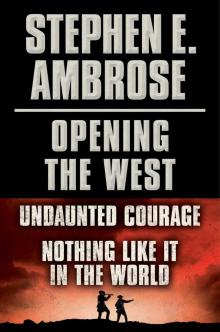 Undaunted Courage
Undaunted Courage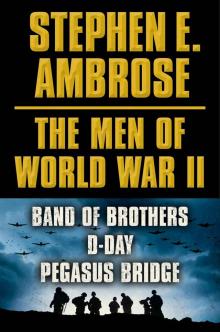 The Victors: Eisenhower and His Boys
The Victors: Eisenhower and His Boys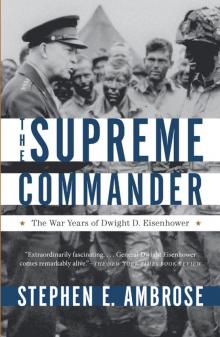 The Supreme Commander
The Supreme Commander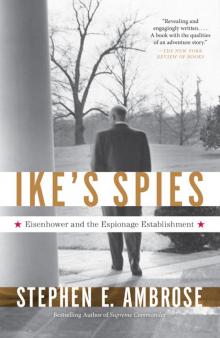 Ike's Spies: Eisenhower and the Espionage Establishment
Ike's Spies: Eisenhower and the Espionage Establishment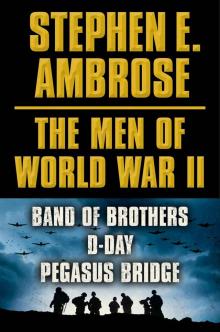 The Men of World War II
The Men of World War II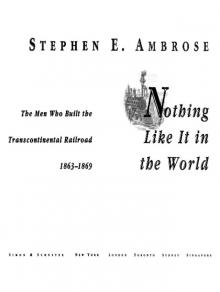 Nothing Like It in the World The Men Who Built the Transcontinental Railroad 1863-1869
Nothing Like It in the World The Men Who Built the Transcontinental Railroad 1863-1869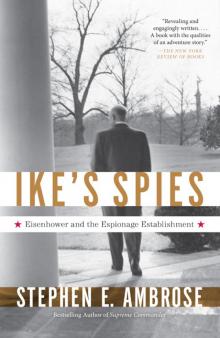 Ike's Spies
Ike's Spies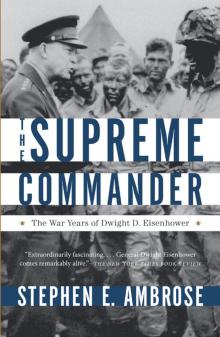 Supreme Commander
Supreme Commander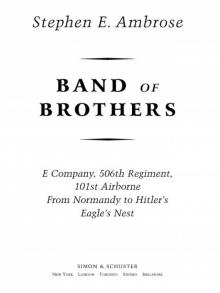 Band of Brothers
Band of Brothers